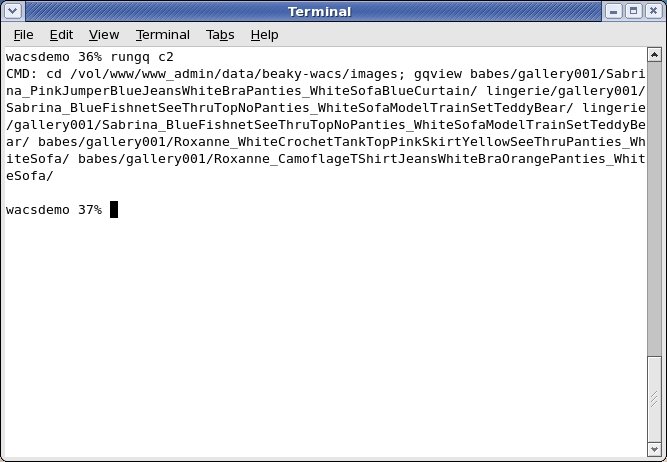WACS being a Linux/Unix application it wouldn't really feel complete without some command line based features! At the moment there's really only two of these that are useful to users of the WACS system (most of the others are targetted at collection administration tasks). These are rungq and runmp - both applications are very similar and can accept similar options and arguments; rungq is for collections of sets containing image files; runmp is for those containing video files.
 |
Rungq in action
The rungq command (and for that matter runmp) can take any one of:
- a saved search
- a connection set
- a model number
To view a saved search containing images you can either simply give the number of the tag set, or you can prefix it with t or tag and it will invoke the Linux/Unix image viewer gqview with a list of actual directories containing the sets to be viewed. This allows the viewing of a slideshow full-screen and at the best possible quality without using a web browser as an intermediary. Generally a local image viewer can do a better job at going full screen than a web browser can.
To view a connection is very similar as you
give it's number prefixed with c or conn
. You can also view all the sets for a given model using the
same mechanism but changing the prefix to m,
mod or model. Additionally any of these
can also be filtered to show only sets of a single type, so for instance
if you want to see only Toy-based sets from model no 10, you can do:
rungq --cat=T mod10.
Rungq should usually work on the web server itself; getting it to work on other hosts means making the files available by NFS in a suitable place, setting up a suitable wacs.cfg file (a copy of the one from the web server usually suffices) and getting the database connection working from Perl. This usually means installing the MySQL client side code (or Oracle equivalent), the relevant Perl DBD/DBI drivers and setting the access permissions on the database to allow database connections from the other host.
Just as the rungq can take a collection of different sets and make a slideshow of them, the runmp command will take a collection of different video clips and string them together as a movie show. The two commands are very closely related and accept all the same options. Both may be used on a single tag set (saved search) or connection which contains a mixture of set types and they will merely ignore the type that they don't handle.